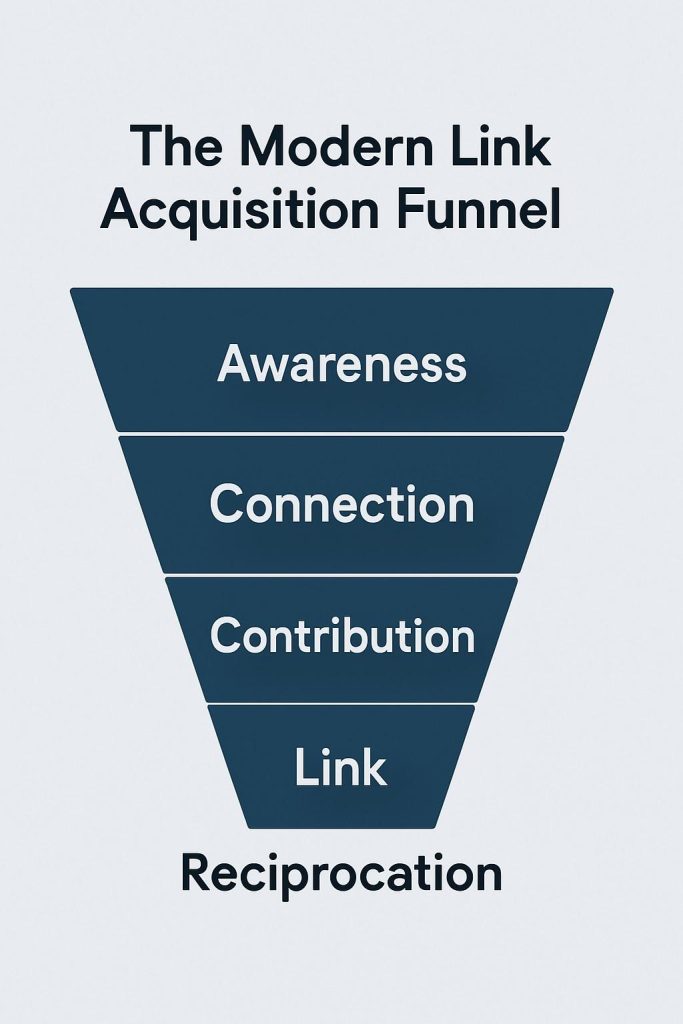Why Most Link-Building Strategies Are Outdated
Ask any SEO professional about link-building tactics, and chances are you’ll hear the same methods repeated over and over—guest posting, broken link building, or directory submissions. While these strategies worked ten years ago, they are either overused or simply not impactful enough in 2025.
Today, link acquisition is about much more than chasing backlinks for ranking signals. It’s about fostering real authority, encouraging engagement from reputable platforms, and delivering value that goes beyond metrics. Forget shortcuts; this is the year to shift focus from quantity to quality to build sustainable, contextual, and valuable links.
Here, we’ll guide you through advanced link acquisition strategies designed for today’s SEO ecosystem to scale authority and consistently produce measurable results.
What Is Link Acquisition in 2025?
Link acquisition in 2025 goes beyond traditional “link-building.” It refers to building strategic, highly contextual connections that prioritize authority and relevance. By focusing on acquiring links from authoritative, trusted, and contextually relevant sources, this practice strengthens a site’s overall domain presence and establishes credibility across its niche.
The Difference Between Link Building and Link Acquisition
The two terms are sometimes used interchangeably, but they’re evolving into distinctly separate practices:
- Link Building involves proactively creating hyperlinks pointing back to your content, often through tactics like guest posting, outreach, and directories.
- Link Acquisition is a broader, more contextual process. It concentrates on strategic relevance, authority partnerships, and real-world value, with brand mentions, collaborations, and earned media often playing a role.
For 2025, link acquisition is no longer just about technical SEO benefits but about becoming a go-to source within your industry.
Must Check: 10 Best SaaS Link Building Agency for Your Business in 2025
Why Google Now Prioritizes Contextual Link Authority
SEO has fundamentally shifted its focus to E-E-A-T (Experience, Expertise, Authority, and Trustworthiness). Google now prioritizes the “context” around a link rather than just its existence.

How Google Analyzes Contextual Links:
- Semantic Search Integration: Google algorithms consider the topic relevance of the linking domain, ensuring only contextually meaningful links matter.
- Degrading Spammy Tactics: Automated outreach and link schemes (e.g., link farms) are increasingly penalized.
- Enhanced Natural Language Understanding (NLU): How and where your links appear within content has become as vital as the domain’s reputation.
For example, links organically embedded in context-rich content, like an instructional blog or expert interview, earn more SEO “trust” than unrelated or buried footer links.
Why spammy outreach and link farms are dying fast
- Low-Quality Links Trigger Penalties: Search engines now use advanced algorithms to detect and penalize websites associated with link farms or spammy outreach, leading to significant drops in rankings.
- User Trust is Paramount: Modern SEO relies on building credibility with users, and low-quality, irrelevant links harm trust, driving away potential audiences.
- Irrelevance is Easily Spotted: Links that do not align contextually with content are flagged as manipulative, reducing their SEO value and potentially impacting the domain’s reputation.
- Algorithm Updates Target Manipulation: With frequent updates like Google’s SpamBrain, search engines actively refine their ability to identify link-building schemes, rendering such tactics outdated and ineffective.
Focus less on raw link volume and more on earning high-quality placements within contextually relevant domains.
The Modern Link Acquisition Funnel
To make link acquisition effective, you need a system, not just disjointed tactics. The modern funnel for link acquisition follows these stages:
Awareness > Connection > Contribution > Link > Reciprocation
- Awareness – Build brand visibility through relevant, authoritative content.
- Connection – Identify and connect with niche-relevant platforms or creators.
- Contribution – Provide value through co-created or collaborative content.
- Link – Request or earn backlinks strategically.
- Reciprocation – Maintain long-term relationships for continued collaboration opportunities.

How to create a system, not just tactics
Focus on building a repeatable, sustainable process. Define clear goals, establish workflows, and measure performance consistently to ensure long-term success beyond one-off efforts.
Pro Tip: Create a visual map of your link acquisition funnel to help align your team and track each stage for optimization.
5 Advanced Link Acquisition Strategies for 2025
Level up your link acquisition with these innovative tactics, complete with actionable steps and tools to implement:
1. Multi-Channel Guest Collaborations
What: Merge guest blogging with podcasts, co-branded PDFs, or social media campaigns for multi-channel exposure.
Why: Diversifying formats boosts outreach opportunities and audience engagement.
How: Use tools like Pitchbox to identify platforms for collaborations.
Example: Launch a podcast guest roundtable that concludes in a downloadable eBook.
2. Collaborative Link Circles
What: Organize trusted peer groups across industries to establish mutually beneficial link practices without spam exchanges.
Why: Builds trust and generates referral benefits while maintaining contextual relevance.
How: Use platforms like Slack or Discord to create reciprocal groups.
Example: Set up an industry-specific Slack channel where members share high-quality link opportunities and collaborate on content partnerships.
3. Data-Driven Interactive Tools
What: Create calculators, surveys, or quizzes that naturally earn backlinks.
Why: Data-driven tools are frequently cited by blogs and content creators.
How: Use platforms like Typeform or Outgrow to design interactive assets.
Example: Build a savings calculator that financial blogs can embed and link back to your site.
4. High-Audience Expert Roundups
What: Conduct roundups featuring expert insights supported by backlink agreements.
Why: Roundups drive traffic and build connections with industry thought leaders.
How: Reach out to experts in your niche, propose mutual backlink benefits, and compile their insights into a cohesive piece.
Example: Publish a blog roundup with expert opinions and include backlinks to their content for mutual promotion.
Other innovative options:
- Surprise product reviews
- Twitter seed-thread backlinks
- Wikipedia citation tunnels
- HARO alternatives powered by automation
The 2025 Link Quality Checklist
When evaluating prospective backlinks, always keep the following checklist in mind:
- Is the link relevant to your site’s content?
- Is the linking domain an authority within the same niche?
- Does the link placement have contextual clarity within natural text flow?
- Inspect the domain for no toxic neighbors or “bad IP” link footprints.
- Avoid mainstream trap errors, like over-optimized anchor text.
- Check if the site has a strong domain authority (DA) and a clean backlink profile.
- Ensure the link isn’t marked as “nofollow” if you’re aiming for SEO value.
- Assess the site’s **traffic quality**—does it receive genuine, consistent visitors?
- Look at the site’s content quality—is it well-written, engaging, and free of spam?
- Confirm the link aligns with your long-term SEO strategy and contributes to diverse link-building efforts.

Auditing Links Strategically
Retaining high-quality links is just as important as acquiring them. Regular maintenance ensures your site remains credible and avoids penalties from search engines. Perform regular audits using tools like Ahrefs or Semrush to spot toxic links, reclaim lost ones, and maintain healthy backlink profiles. These tools provide detailed insights into your link profile, helping you identify opportunities for improvement and risks to address.
What to Audit:
- Good Links – Keep and nurture these. Build strong relationships with the sites providing these links, and consider collaborating on future content or partnerships to strengthen those connections further.
- Broken/Missing Links – Attempt to repair them through outreach. Engage with website owners to restore these links, or redirect users to updated pages if the original content has moved.
- Toxic Links – Use Google’s Disavow Tool judiciously to remove harmful backlinks. Be cautious with this tool, as disavowing the wrong links can negatively impact your SEO.
Pro Tips for Backlink Auditing:
- Monitor Your Competitors: Keep an eye on your competitors’ backlinks to identify potential link-building opportunities in your niche.
- Set Alerts: Use monitoring tools to set alerts for any sudden changes in your backlink profile, such as spikes in toxic links or high-quality links being removed.
- Diversify Your Backlinks: Ensure a mix of links from different domains, including blogs, media, and industry sites, to maintain a natural-looking profile.
- Focus on Link Context: Pay attention to the anchor text and the context in which your links appear. Relevant, natural placements are more valuable than generic or spammy ones.
Conducting thorough and consistent backlink audits will help you maintain a healthy link profile, boost your SEO performance, and protect your site from potential penalties.
How to Make Link Acquisition a Flywheels
The secret to scaling link-building success lies in automation and efficient management.
- Invest in CRM tools to manage outreach campaigns and maintain partner relationships. A solid CRM allows you to track communication history, set reminders for follow-ups, and organize prospects in one place for seamless management.
- Use AI to optimize email templates, pitch ideas, and automate follow-ups. AI tools can personalize outreach at scale, ensuring each pitch resonates with its recipient, increasing response rates while saving time.
- Leverage tools like Zapier to integrate multiple link acquisition workflows. Automate repetitive processes like importing leads, updating contact statuses, and syncing data between apps, making your workflows faster and error-free.
- Prioritize content quality and create link-worthy assets. High-quality, authoritative content naturally attracts backlinks and makes outreach pitches more compelling. Consider producing unique research, infographics, or in-depth guides that provide real value to your audience.
- Build strong relationships with industry peers and bloggers. Networking can lead to ongoing link opportunities and collaborations, turning one-time successes into long-term strategies.
By combining automation with strategic planning and relationship-building, you can create a self-sustaining link acquisition process that continues to grow over time. These processes ensure you’re always moving forward—even when time is limited.
Avoid These Common Mistakes in 2025
Even experienced marketers fall victim to these outdated or harmful practices:
- Relying too heavily on outdated link directories.
- Using overly keyword-stuffed anchors.
- Failing to prioritize mobile-first SEO context in links.
- Publishing AI-generated content without proper editorial oversight.
- Ignoring the importance of E-E-A-T (Experience, Expertise, Authoritativeness, and Trustworthiness) in content strategy.
- Overlooking the impact of core web vitals on search rankings and user experience.
- Neglecting to leverage structured data for rich snippets and better visibility in search results.
- Focusing only on quantity over quality when building backlinks, leading to low-authority connections.

Build Smarter Links Now
Link acquisition in 2025 has evolved into a relationship-driven strategy that prioritizes authority, quality, and context. By focusing your efforts on scalable, advanced tactics, you can drive meaningful growth, build authority in your niche, and create a sustainable competitive edge.
Book a FREE Demo today to discover how our tools can jumpstart your link acquisition strategy and help you outpace the competition.
Frequently Asked Questions (FAQ)
What is link acquisition?
Link acquisition is the process of gaining hyperlinks from other websites to your own. These links, also referred to as backlinks, help drive traffic, improve search engine rankings, and establish your website’s authority in your niche.
Why is link quality more important than quantity?
High-quality links from reputable sources carry significantly more SEO value than numerous low-quality links. Search engines prioritize trustworthy and contextually relevant links, making them far more effective for improving rankings and credibility.
How can your tools improve my link acquisition strategy?
Our tools are designed to streamline the link acquisition process by identifying high-authority opportunities, automating outreach efforts, and providing insights to make data-driven decisions. These features help you save time and maximize results.
Can I use these tools for any industry?
Yes, our tools are versatile and can be customized to fit the needs of various industries and niches. Whether you’re in e-commerce, technology, finance, or any other sector, our tools can support your link-building goals.
What sets your platform apart from competitors?
We offer advanced features like AI-powered prospecting, relationship management tools, and real-time analytics. Our focus is on delivering measurable results through a user-friendly interface and personalized support.




